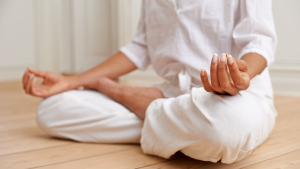We hate it. We fight it. We develop bad habits to avoid and ignore it. But (spoiler alert) stress isn’t goin’ anywhere anytime soon. And neither is its partner-in-crime, anxiety. They’re here for the long haul; and we can either deny and deflect or we can meet them head-on. As obvious as it may sound, stress- and anxiety-management are ongoing, challenging commitments. And, surprisingly, if we’re up for the challenge, we’ll discover in the process that both stress and anxiety are normal. And they come bearing gifts. Creating your own stress and anxiety toolkit, with techniques for stress- and anxiety-management, will help.
Stress is simply the body’s reaction to a perceived threat, and anxiety is the body’s response to a perceived threat. Put another way, stress is the response to an external trigger, and anxiety is the persistence of worry.
Neither is something you just “get over”.
Contrary as it may sound, both stress and anxiety have self-preservation as their mission statement. But their good intentions don’t always “play nice” with a desired peaceful flow to life.
You can, however, create your own personalized stress and anxiety management toolkit, complete with tailored techniques to help you manage stress and worry.

The key ingredient here is finding what stress- and anxiety-management techniques work best for you. And operating from self-compassion, patience, and resilience (hopefully) goes without saying.
20 Practical, Doable Strategies For Managing Stress and Anxiety
The purpose of presenting what may seem like “just another list” isn’t to give you yet another standard to live up to. It’s to show you that you always have options.
Every day, every moment, every stress-filled situation: They all offer you the opportunity to choose a reaction or response. And what you choose can have far-reaching effects, creating effective, compassionate habits for responding to future stress and anxiety.
So, as you read through this list of tips you may have heard before, choose to read with a new perspective.
Chances are you’re not the Dali Lama (if you are, welcome, Your Holiness). You have a busy life in a busy world, and mastering 20 steps toward anti-anxiety zen probably didn’t make your calendar. (But, in addition to the list below, you might benefit from reading the Dali Lama’s advice for dealing with stress and anxiety.)
Reflect, then, on the essence of each strategy: its inherent value in the moment and future. What situations lend themselves to a given strategy? How can you implement even one today and contemplate its benefit to your life? What suggestions would be “nice” to try but just “not right now”? How can you shape the strategy to fit your own life and personality?
Knowing that you have options – and that those options have your best interest at heart – is stress- and anxiety-relieving in itself.
Here, then, are 20 doable tips for stress- and anxiety-management:
1. Practice mindfulness and meditation.

Mindfulness and meditation are powerful tools for anxiety and stress management. By focusing on the present moment and training the mind to observe thoughts without judgment, you can reduce the power of your worries.
- Daily meditation: Set aside 5-10 minutes each day to practice meditation. Apps like Headspace or Calm can guide you through simple exercises.
- Mindfulness techniques: Mindfulness, in a nutshell, is about consciously directing your awareness to the present moment. It involves slowing down and paying attention to the content of “now” – sights, sounds, feelings, thoughts, breath – without judgment.
2. Write about it.

- Create a concern journal: Writing down worries can be therapeutic. A concern journal allows you to express your fears and anxieties in a structured way, freeing your mind from constant rumination.
- Daily entries: Spend a few minutes each evening writing down your worries. Try to categorize them — those you can control and those you can’t.
- Problem-solving: For worries you can control, write down actionable steps you can take. For those you can’t, practice letting them go, reminding yourself that some things are beyond your control. (His Holiness the Dali Lama is a big fan of this one. “If you can’t control it, there’s no use in worrying.”)
3. Establish a routine.

Anxiety often thrives in uncertainty. Establishing a daily routine can create a sense of stability and predictability.
- Morning rituals: Start your day with a consistent routine that includes activities you enjoy, whether it’s a cup of tea, a short workout, or reading a favorite book.
- Plan your days: Use a planner to organize your week, blocking off time for work, self-care, and relaxation. Knowing what’s ahead can significantly reduce anxiety. And making self-care a scheduled non-negotiable will increasingly influence the way you make choices and manage stress.
4. Limit news consumption.

In today’s digital age, constant news alerts can heighten anxiety. Reducing exposure to distressing news can help manage worries.
- Set boundaries: Designate specific times to check the news or social media instead of constantly scrolling throughout the day.
- Focus on positives: Follow positive news outlets or social media accounts focused on uplifting stories to counteract negative influences.
5. Engage in physical activity.

Exercise is a way to reduce anxiety and boost mood. It releases endorphins, chemicals in the brain that act as natural painkillers and mood elevators.
- Find what you love: Yoga, dancing, swimming, running, trampolining with your kids: Simply choose activities you enjoy. This will make it easier to stick with a routine.
- Short bursts of activity: If time is tight, incorporate short bursts of activity into your day. A quick walk or a few stretches can uplift your mood and reduce anxiety.
6. Practice deep-breathing and relaxation techniques.

Breathing exercises can help calm your nervous system and shift your attention away from worries.
- Deep-breathing exercise: Inhale deeply through your nose for a count of four, hold for four, and exhale through your mouth for a count of six. Repeat this several times until you feel calmer.
- Progressive relaxation: Tense and then relax each muscle group in your body, starting from your toes to your head. This technique can help release built-up tension.
7. Connect with nature.

Spending time in nature has been shown to reduce stress and anxiety levels. It can help put your worries into perspective and bring a sense of peace.
And integrating nature therapy techniques, which rely on the calming effects of nature for mental well-being, can have similar benefits.
- Nature walks: Make a habit of going for walks in parks, forests, or along the beach. Focus on the sights, sounds, and smells around you. If you have a dog, use your walks as an opportunity to sniff out new trails and places for discovery.
- Gardening: If you have access to a garden or even a small balcony, try growing plants or flowers. Even small-scale gardening can connect you with nature and provide a sense of accomplishment.
- Ecotherapy: Look into ecotherapy programs, where therapeutic activities take place in natural settings. This can enhance feelings of connectedness and reduce stress.
- Nature sounds: Create a calming atmosphere indoors with nature sounds or visuals. Whether it’s a sound machine with bird songs or indoor plants, nature can play a pivotal role in promoting calm.
8. Notice caffeine intake. Adjust if necessary.

High amounts of caffeine can exacerbate feelings of anxiety. Monitoring your intake can lead to greater emotional stability.
- Consider herbal teas: Replace coffee with herbal teas, such as chamomile or peppermint, that are naturally calming.
- Snack choices: Choose snacks that are nutrient-dense and balanced, such as fruits, nuts, or whole grains, to maintain steady energy levels throughout the day.
9. Set realistic goals.

Anxiety can stem from feeling overwhelmed by the demands of everyday life. Setting achievable goals can help break tasks down into manageable steps.
- SMART goals: Use the SMART framework (Specific, Measurable, Achievable, Relevant, Time-bound) when setting goals. This clarity can alleviate the stress of ambiguity.
- Celebrate small wins: Acknowledge and celebrate each achievement, no matter how small. Think this sounds hokey? Research actually shows that tracking small wins triggers the brain’s reward (dopamine) center. And this can boost confidence and reduce feelings of inadequacy.
10. Seek support from others.

Connecting with friends, family, or support groups can provide a valuable outlet for expressing feelings and concerns.
- Talk it out: Don’t hesitate to discuss your anxieties with trusted loved ones. Sometimes just voicing worries can diminish their intensity.
- Professional help: Consider seeking therapy or counseling if feelings of anxiety become overwhelming. Professional help can provide you with additional tools and techniques tailored to your needs.
11. Prioritize self-care.

Self-care is essential for mental health and can significantly reduce anxiety levels. Prioritizing time for yourself isn’t selfish; it’s necessary for maintaining emotional balance and resilience.
- Schedule “me time”: Set aside specific times each week dedicated entirely to activities that bring you joy or relaxation, whether that’s a spa day at home, reading, or pursuing a hobby.
- Pamper yourself: Small acts of self-care, like taking a long bath, applying face masks, or engaging in your favorite crafts, can foster a sense of calm and fulfillment. Find ways to show love to yourself, just as you would a cherished friend.
12. Limit overcommitment.

Women especially tend to say “yes” to too many things, leading to stress and burnout. Learning to say no can be liberating and help maintain your peace of mind.
- Evaluate commitments: Reflect on your current commitments and assess which are truly important to you. It’s okay to let go of things that don’t serve your personal needs or goals.
- Practice saying no: When asked to take on more responsibilities, allow yourself the time to think before responding. It’s acceptable to decline politely when it doesn’t align with your well-being.
13. Adopt a growth mindset.

Cultivating a growth mindset — the belief that you can develop and grow through challenges — can help transform how you respond to anxiety and setbacks.
- Reframe negative thoughts: Instead of focusing on what could go wrong, consider what could go right. This shift in perspective can open the door to opportunities rather than spiraling into fears.
- Embrace mistakes: View mistakes as learning opportunities rather than failures. Remind yourself that everyone makes mistakes, and they’re often the building blocks of success.
14. Establish boundaries.

Setting healthy boundaries is vital for managing anxiety, especially in relationships and work environments.
- Recognize your limits: Understand what you can realistically handle, whether it’s work responsibilities, family obligations, or social engagements.
- Communicate clearly: Be direct with others about your boundaries. When you let people know your limits, you’re more likely to maintain balance in your life and reduce overwhelm.
15. Engage in creative outlets.

Creative activities can serve as a wonderful distraction from anxiety and provide an emotional release.
- Arts and crafts: Painting, drawing, knitting, or other crafts enable self-expression and can transport your mind away from worries, making them superb anxiety-management techniques. Highly Sensitive People (HSPs) are natural-born creatives and know, innately, how essential creativity is to sense-of-self and peaceful living.
- Writing: Writing poetry, journaling, or even storytelling can help clarify your thoughts and feelings, making them easier to manage.
16. Limit alcohol and substance use.

While it may be tempting to use alcohol or other substances to cope with anxiety, they often exacerbate the problem in the long run. Definitely resist using either alcohol or other drugs as anxiety-management techniques.
- Find alternatives: Instead of reaching for a drink, try alternatives that promote relaxation, such as herbal teas, smoothies, or non-caffeinated beverages.
- Mindful drinking: If you do choose to drink, do so mindfully. Pay attention to how it makes you feel and consider limiting your intake to manageable levels.
17. Cultivate gratitude.

Practicing gratitude can shift focus away from worries and enhance overall well-being. It is a tried-and-true anxiety-management technique that builds over time.
- Gratitude: Each day, write down three things you are grateful for, no matter how small. (Perhaps tie this exercise in with tracking your small wins mentioned in #9 above.) This exercise can help highlight the positives in your life and reduce anxiety.
- Reflect on joy: When feelings of anxiety arise, take a moment to pause and reflect on what’s good in your life. This can serve as an immediate grounding technique.
18. Declutter and simplify.

Mastering stress and anxiety is, in an obvious nutshell, about creating inner peace.
Yes, there are those enviable experts who can sit tranquilly in lotus in the middle of a war zone. But most of us would consider it a victory to navigate traffic calmly and get a good night’s sleep.
If there were only fewer deadlines, less to clean and keep track of, more space, more time….Well, there can be, and you may find the answer right at home.
- Make your bed: Believe it or not, there are beyond-house-proud reasons for making your bed. It starts your day off with a (seemingly) small accomplishment. And it rewards you at the end of a long day with a welcoming invitation to a peaceful night’s sleep. This singular discipline is so powerful that Navy Seal and Admiral William H. McRaven wrote a book by the same name: Make Your Bed.
- Keep only what brings you joy: Decluttering and prioritizing on the outside has an almost miraculous ability to declutter and prioritize on the inside. Not only will you feel a sense of accomplishment, but you will give your home and life clarity. And being able to see clearly reduces stress and anxiety and boosts effective decision-making.
19. Limit multi-tasking.

Juggling multiple tasks at once can increase stress and anxiety levels. Think about it. If the brain’s short-term memory can store only about 7 items at a time, is it any wonder that multi-tasking fails?
Try focusing on one thing at a time for better management of your worries. (Remember that “mindfulness” tip in #1?)
- Practice single-tasking: Try to accomplish tasks one at a time, allowing yourself to complete each fully before moving on to the next. This can increase productivity and decrease feelings of being overwhelmed.
- Use timers: Consider using the Pomodoro Technique: work for 25 minutes, then take a 5-minute break. This practice can maintain focus while providing necessary breaks to recharge.
20. Seek out a support group.

Joining a support group can provide a much-needed sense of community and space for sharing experiences with others who understand what you’re going through. You may just pick up some helpful anxiety-management techniques too.
- Online or in-person groups: Look for local or online groups focusing on anxiety-management techniques or specific concerns that relate to your life. Sharing and hearing stories can facilitate healing.
- Professional guidance: Some groups are led by mental health professionals, providing structured support and coping strategies.
Conclusion

Managing anxiety and worries is a continuous process that needs attention, practice, and a willingness to explore different strategies.
The goal is to create a healthier relationship with thoughts, thereby reducing anxiety’s power over you.
By implementing practical approaches like those listed above, you can develop a sense of agency, reduce anxiety’s hold, and foster a more balanced mindset.
Remember that it’s about finding what works best for you – always within a context of self-compassion, patience, and resilience.
You’ve got this.
Dr. Elayne Daniels is a private-practice psychologist, international consultant, and coach. Over the last 25 years, she has helped people heal and deal with depression and anxiety. To learn more about how she might help you, contact her here.
